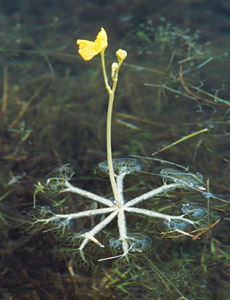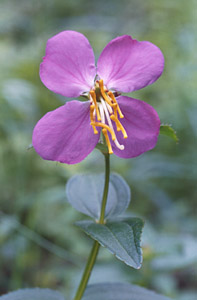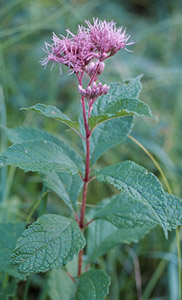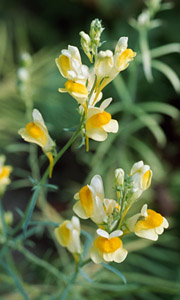



Swollen Bladderwort, Bladderwort family (Lentibulariaceae), Native
 |
 |
 |
 |
Floating inconspicuously in shallow water along the shores of the Reservoir, small swollen bladderwort plants (Utricularia inflata) can appear as early as July. They usually become much more abundant as water levels drop during the advancing summer. This aquatic plant bears small, yellow, snapdragon-like flowers and has a whorl of inflated, spoke-like leaf stalks that serve as floats. The plant is only a few inches high.
Like other bladderworts, swollen bladderwort is a carnivorous plant. Some of its underwater parts bear
numerous tiny bladders, each with a trap door and a hair-like trigger, that capture and digest minute
water organisms, such as insect larvae and tiny crustaceans. Like showier and more well-known
carnivorous plants such as the Venus flytrap, bladderworts have evolved to get certain nutrients,
such as nitrogen, from tiny organisms rather than from the soil or water. The reason is that the acidic
environments in which they usually grow tend to be poor in such nutrients.
Virginia Meadow-Beauty or Deer Grass, Meadow-Beauty family (Melastomataceae), Native

|
In sunny, wet, sandy areas, such as the stream bed near the Reservoir when water levels are low, Virginia meadow-beauty (Rhexis virginica) blooms in late summer. The deep rose-colored flowers look slightly lopsided. Drooping from their centers are distinctive long, thin, yellow anthers (male, pollen-bearing parts) and a long curving pistil (female flower part, white in the photo). The flowers are showy, like many other members of the largely tropical meadow-beauty family.
The leaves grow in pairs and have obvious parallel ribs. They turn red in the fall. Also called deer grass, the plant is supposedly a favorite food of deer in more western parts of the country.
To get pollen from meadow-beauty flowers, bees such as bumblebees must hang on and vibrate the pollen
out of the anthers, using their wing muscles. After a day or so in bloom, the yellow anthers change
color, becoming duller. While an older flower is still showy enough to attract bees to its
vicinity--where other, fresher meadow-beauty flowers also grow--the color change may help to signal
to pollinators that the older flower's pollen has already been used up.
Spotted Joe-Pye-weed, Composite or Daisy family (Compositae), Native

|
Along the edges of sunny, swampy areas, stands of spotted Joe-Pye-weed (Eupatorium maculatum) become apparent in August. These tall plants have flat-topped clusters of closely packed purple flowers. They lend color to any landscape that includes stands of them. The flowers attract bees and butterflies, but the plant can also pollinate itself as the flower parts brush against one another.
The plant is named for Joe Pye (or Jopi), who, according to folklore, was a traveling Native American medicine man. He lived in New England around the time of the American Revolution and may have been from a tribe in Maine. He sold various herbal remedies to the colonists and apparently treated typhoid fever with the plant that bears his name to this day.
There are a few different species of Joe-Pye-weed, but spotted Joe-Pye-weed is the most common. It has
a deep purple or purple-spotted stem, unlike other varieties.
Butter-and-eggs, Snapdragon or Figwort family (Scrophulariaceae), Alien


|

Butter-and-eggs spreads both by seed and by underground stems called rhizomes, and it can form large colonies. It needs to grow among other plants because it is parasitic. Its roots tap into other plants' roots, taking water and salts but without killing the other plants.
Although the butter-and-eggs had medicinal uses in the past, its juice was also mixed with milk to make a
fly poison. The flowers have been a source of yellow dye.

| show TOC frame | Table of Contents | 
|
| Home / Contact | ||
Copyright © Anne A. Reid, 1999-2002. Photographs copyright © Garry K. Kessler, 1999-2002. | ||